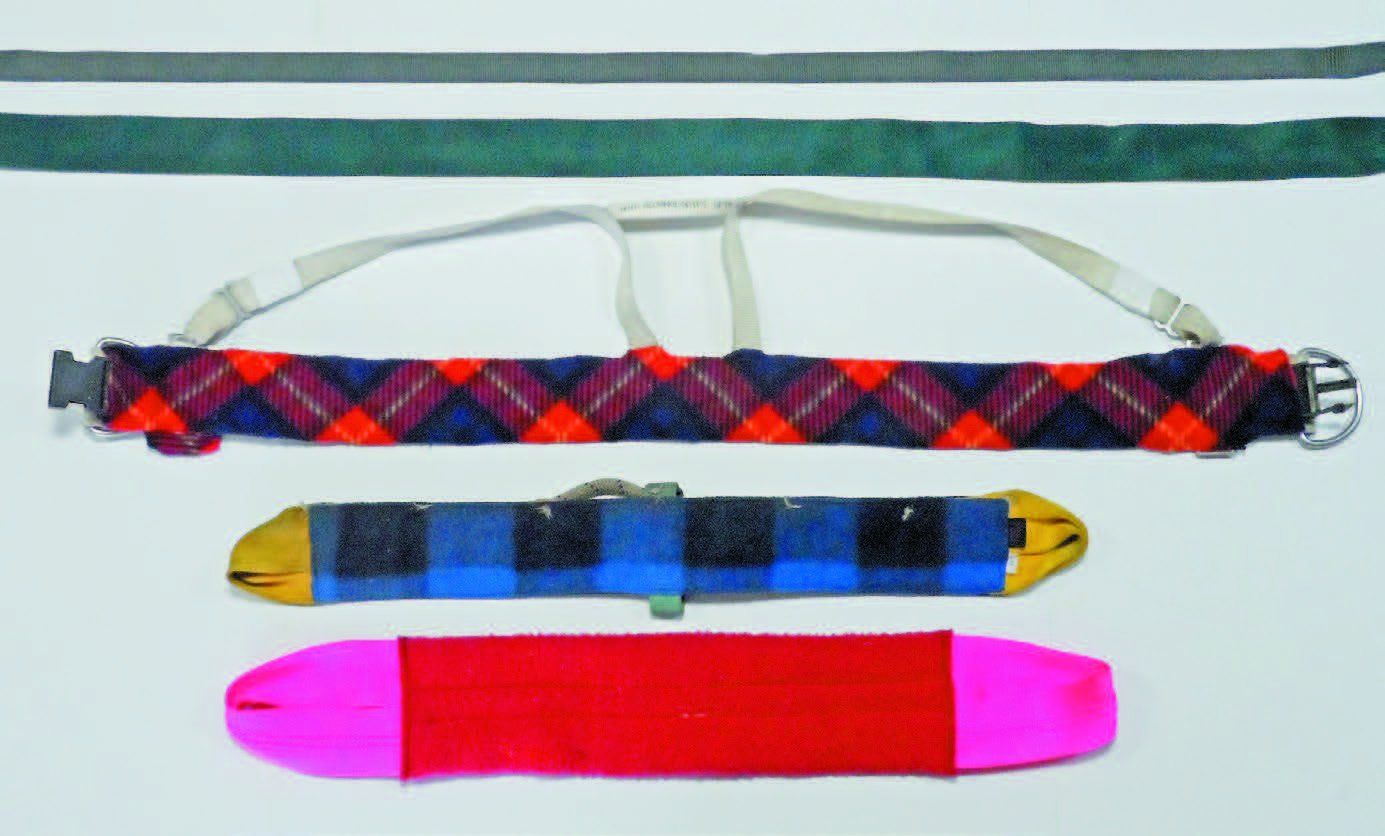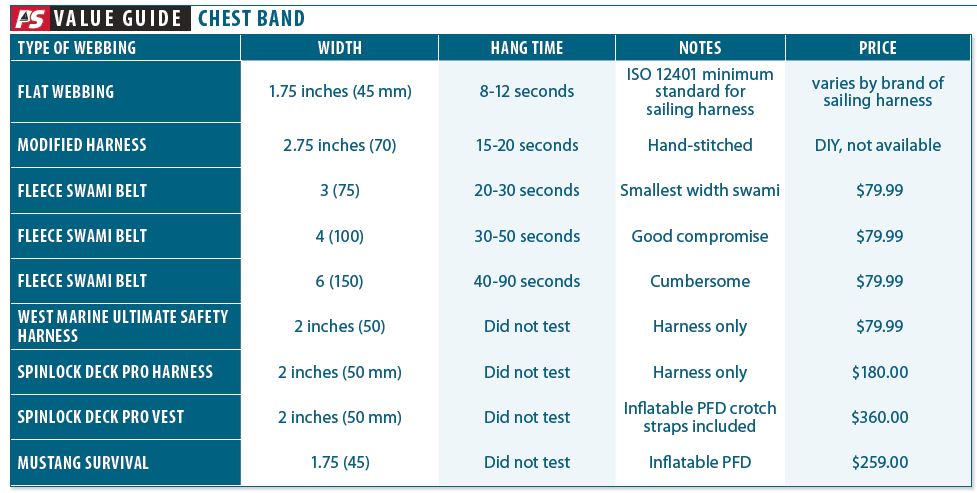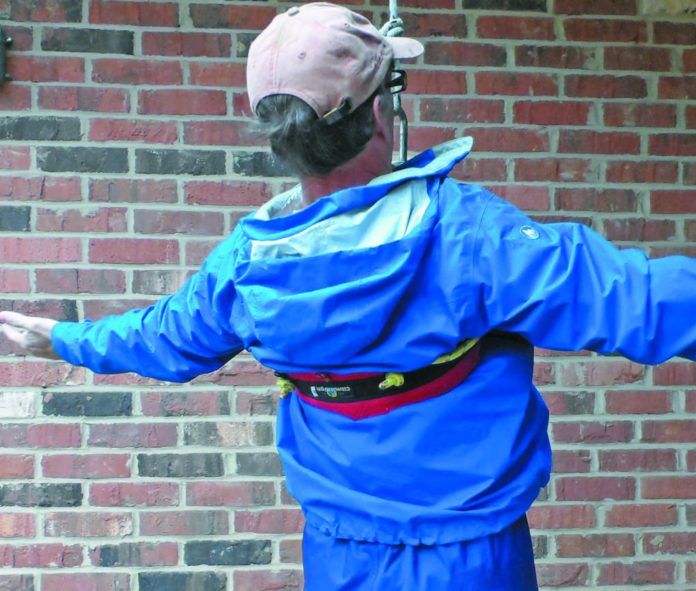When we buy rain gear, deck shoes, or binoculars, we assume they’ve been tested, not just in the factory and in the lab, but just as importantly, in the field in the normal manner of use. If a climbing company develops a new carabiner, rope, or harness, you can bet they give prototypes to their sponsored climbers, with instructions to take them out in the mountains and fall on them.
And we’ve learned the hard way that this isn’t always the case with some sailing safety equipment. The history of inflatable PFDs is sprinkled with voluntary manufacturer recalls for reasons ranging from concerns about bladder construction to the reliability of the inflation mechanisms.
Last month we suggested improved leg loops for harnesses or existing PFDs instead of crotch straps. This month we look at chest harnesses. Both are suggested as ways to improve survival in a fall.
It is unlikely that any harness makers have done any drop testing using actual people, even through that is the ultimate purpose. The risk of injury is far too high. The UIAA (international climbing gear standards organization) has adopted a strict testing protocol, based on European Standard EN 12277 Mountaineering Equipment Standard – Harnesses. Of interest is Note 1 in the test methods which describes the high risk of injury during a fall wearing only a chest harness.
. . . 3.1.4, chest harness (type D). Harness which fits around the upper part of the body around the chest and under the armpits . . .
NOTE 1. This type of harness alone cannot support a person in the hanging position without permanent injury in less than one minute.
In the event of a hard stumble across a sloping deck, or a tumble that sends you over the side, you can expect an impact force of 500-1,200 pounds from the webbing on a contemporary sailing harness. Thats quite a wallop to take on the rib cage, concentrated across a band with a width of only 45 millimeters-a common dimension for a contemporary sailing harness.
Over the past three years we’ve been looking at all aspects of fall protection systems-safety tether snap-hook strength (PS March 2018, jackline strength and energy absorption (PS November 2015), tether energy absorption (PS December 2017), clip in locations (PS May 2017)-all in the interest of keeping you on the boat and minimizing the jolt to your body. Now we take a look at one of the more vulnerable areas-your chest.
In the early days of climbing a simple rope harness was tied around the chest. Ropes were made from hemp and climbers tried extremely hard not to fall, since even with the rope and harness, injury was likely. In the 1960s a few commercial chest harnesses became available, but they were still painful and dangerous.
Strange as it might seem, they learned it was actually safer to tie a rope around the waist. If the rope was coiled around 6-8 times and gathered up with a modified bowline (bowline on a coil), the result was acceptable for minor falls and short hangs, even better than a chest harness. Or course, it helps if you are young, fit, and have a strong core.
In the 70s and early 80s climbers migrated to what was called a swami. At first, 2-inch wide webbing was wrapped twice around the waist in a wide band and cinched tight, but this was a poor solution. Climbing stores then started producing a 3- to 4-inch wide fleece-covered version, with loops at each end to allow lashing it tight around your waist with webbing.
This was an improvement, although still pretty unpleasant after about 30 seconds. Interestingly, they never evolved wider than 4 inches; wider was cumbersome and it really didn’t help that much. But 4 inches is 100 mm, a lot wider than the meager 45 mm ISO standard for sailing harnesses. Soon legs loops were added, creating the first modern climbing harnesses (see PS November 2018).
In Clipped In-Safety Harness Showdown, (see PS December 2006), we reviewed many common harnesses, and testers at that time concluded that the width of the webbing didn’t matter that much. However, the range of widths we tested-1.5 to 2 inches-was too limited for testers to notice a significant difference. We also noted during that test that thigh straps offered improved safety in a fall, a position we reiterated in the December 2018 issue.
What We Tested
For this test, testers dangled themselves from 1-inch and 2-inch webbing straps. They also tested the following: sailing harnesses with ISO 12401 standard straps 45 mm (1.75 inches), harnesses with wider 2.75-inch straps, 3-inch wide fleece-covered swami belt (used as a chest harness), 4-inch wide fleece-covered swami belt (used as a chest harness), and several non-inflatable PFDs (these are not rated for this purpose-testers used them to evaluate load distribution).
How We Tested
The testing was subjective, but the methodology and repetition gives us a high confidence in the data. And it was straightforward. Alternately donning each sample, testers hung suspended in each sample until it became too painful. Each sample was tested multiple times, in reversed order, over a period of days to avoid any bias due to cumulative soreness or fatigue.
Observations
Pain, hang time, and, most probably, impact survivability relate directly to width. The one-inch webbing was too painful under partial body weight to attempt it under full body weight. The ISO standard 45 mm band wasn’t much better; testers could only allow their full body weight to be suspended for a few moments at a time. We believe the UIAA statement that permanent injury is possible after one minute would apply to this chest bands of this width. While wearing bands of greater widths from 2 to 2.75-inches, short hangs of 20 seconds were possible and didn’t leave any lasting soreness.
By the time testing with the 4-inch fleece swami began, it was clear that testers had finally reached a usable width. This shouldn’t be surprising, since this is the width used for emergency rescue slings.
This minimum was not established for comfort, but rather for safety. When increased further to 6 inches, testers could finally endure hanging for a period of 30 seconds without real discomfort. This period could extend to a few minutes in a real emergency. But this width seemed cumbersome for daily wear.
The narrower the chest band, the greater the temptation to grab the tether due to the pain. This only exacerbates the situation, since reaching up to grab the tether further narrows the chest, allowing the chest band to slide up more. The more the harness slides into the arm pits, and the more it hurts.
The wider-band harnesses (3-4 inches) stayed farther down on testers bodies, partly because the pain didn’t cause testers to reach upward for the tether to relieve strain. So long as the wearer didn’t not reach up to grab the tether, the chest band was prevented from sliding further by the latissimus dorsi and other larger muscles.
Fleece and other padding improves comfort and helps with minor bumps at light loads, like when the tether comes tight while bouncing on deck. However, under body weight or in the event of a significant fall, don’t expect padding or heavy clothing to make any difference at all.
The fleece makes these harnesses more difficult to don over heavy clothes. In fact, foul weather gear always makes it more difficult to achieve a proper fit; the harness tends to slide up into the armpits. The simplest, most effective way to prevent the chest strap from riding up is to add width, which also allowed for better load distribution.
We thought a foam-filled, inherently buoyant PFD used as a harness might suggests that a fitted vest could work better than a band. In fact, it was just as painful.
How do wider bands relate to injury potential? Bruising is probably directly related to the hang time rating. Broken ribs are less likely. Ease of breathing is improved, but not in proportion to hang time, since the amount of compression is unchanged, just distributed better.
Is there a practical upper limit for width? The strap cannot be closer than a few inches to the armpit at rest or it will chafe. Once tensioned, the band must move above the lower ribs to prevent injury. This limits the load-bearing width of the band to about the length of the sternum, or about 6 inches.
In terms of everyday comfort, the ideal webbing width can depend upon climate. The wider bands (up to about 4 inches) pose no discomfort in winter clothes. In hotter climates, a 6-inch band will likely be uncomfortable on hot days. However, the bulkiness is offset by less pressure on the skin. Increasing the width from 45 mm to 70 mm better distributes harness pressure on the body during everyday activities, allowing the harness to be suitably snug without it digging in.

Fit for Safety
Chest harnesses are dangerous to hang from, even under controlled conditions; taking a fall can be lethal. Small wonder they have been banned from climbing for nearly 40 years. In the sailing realm, however, incorporating a broader, four-inch, chest band into existing harness designs would be a welcome improvement.
If the chest band is thin or poorly fitted it can cause injury or slide off-this has happened more than once in sailing accidents. The band needs to be wider, and the wearer must adjust to the correct fit. He can’t just pull the harness of over his or head and tighten until it is comfortable. The harness needs to be in the right position when the load comes on. This applies to both separate harness and combined vest/PFD combinations.
Height. The chest band must fall on the sternum, preferably the mid to lower portion. This can be difficult for small sailors and women (the typical lower limit for universal harnesses is 5 feet 5 inches), but if the load increases on your lower ribs they will break. Failing that, you wont be able to breathe because of compression and because your diaphragm may spasm (as it does when you get the wind knocked out of you). When in doubt about how to use a chest band, read the instructions.
Snugness. It is important that the harness fits snugly enough that the chest band tightens up on the latissimus dorsi rather than sliding up into the armpit, where it will cut off blood flow, pinch and damage major nerve bundles, and hurt like crazy. To accomplish this, the band should feel noticeably snug when you inhale and flex. It shouldn’t be so tight that you can’t breathe or work, but you should know it is there.
Leg loops. Unless you have considerable shoulder span and wear the harness snug, it can slide off over your head if you exhale and lift your arms. Loose foul weather gear makes this even more likely. For this reason, thigh straps are recommended (see PS December 2018).
Fitness. If you are overweight or naturally weak in the shoulders (can you do 10 pull-ups?) and have less muscle mass to protect nerve bundles, you will be even more susceptible to injury. After fitting your harness, try some gentle hangs from a halyard, starting with less than full body weight, but eventually getting your feet off the deck. Fit the leg loops and see how they behave under load. See what it takes to keep them in position. This is the time to learn.
Conclusions
The width of the chest band is just one of many factors to consider when evaluating harnesses and PFD/harness combinations. However, in the event of a hard catch against a tether, there is no substitute for generous load distribution. We encourage you to try the hang test before you buy. Were also hoping equipment manufacturers and sailing standards committees take this to heart, increasing the standard from its current painful and dangerous 45 mm to a more functional 75-100 mm.
We can’t expect sailing harness designs to change overnight, but the bottom line is that our tester has switched to a custom harness with a 70 mm chest band, not just because it is safer, but because it is more comfortable. The extra width and fleece lining reduced pressure and pinching even at rest. A win-win solution.




































